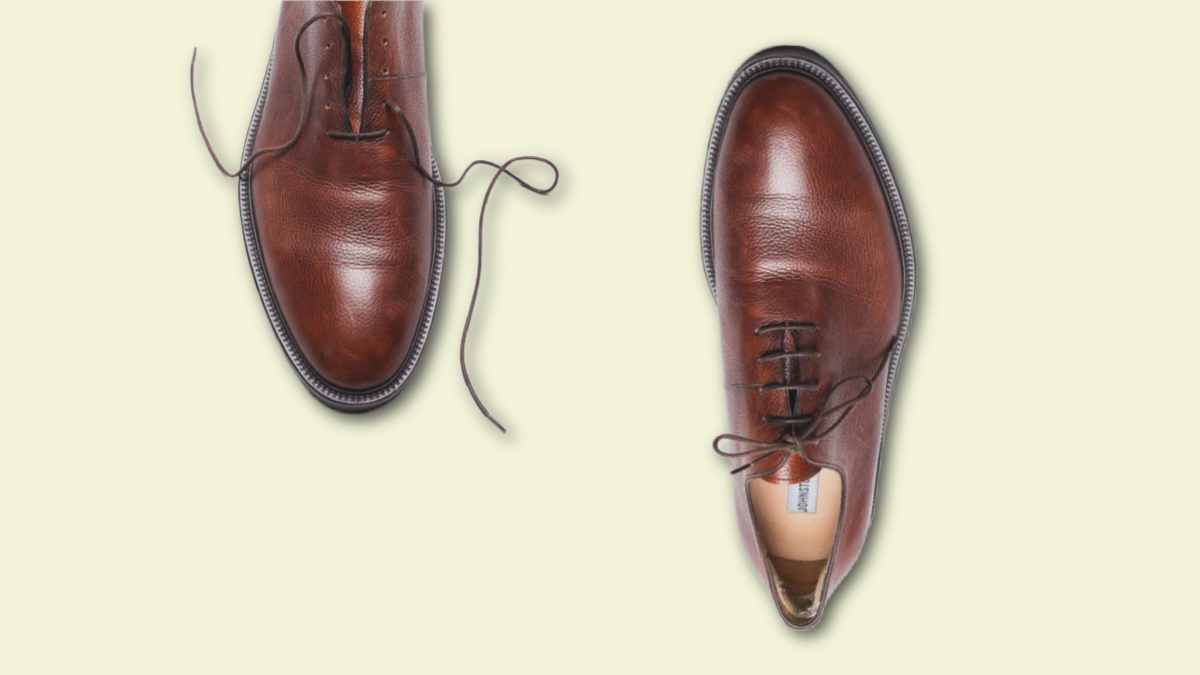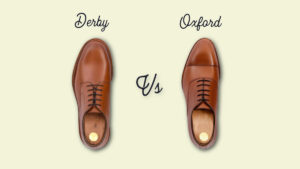The proper ways to tie your dress shoes include the straight-forward bar lacing composition, great for oxfords and wholecuts, the easy criss cross, which suits detailed shoes like brogues, and the versatile diagonal style. Advanced compositions include the complex and eye-catching lattice, the minimal over under, and the unique vice versa.
Just like there isn’t one way to do your hair or tie a tie, there’s not one right way to lace your dress shoes.
However, nothing says grown-up and well-adjusted than dressing purposefully.
We’re going to show you six different lacing techniques. Each has a different aesthetic, so we’ll also hit on which compositions go best with certain shoes, personal styles, and intentions.
Let’s get to it.
Table of Contents
What You’ll Need
- Proper, waxed cotton dress shoe laces. They should be thin, flat laces or thin round ones—never athletic nylon laces
- Your favorite pair of dress shoes
Tying Dress Shoes With an Odd Number of Eyelets
If your shoe has an odd number of eyelets, the important thing to do is to make sure that one end of the lace is slightly longer than the other when you start threading it through. This way, you have slack to make up for the unevenness. Give the longer side of the lace about an inch extra.
Ideally, but not necessarily, it helps to bring your laces in through the underside of the bottom two eyelets so that your first bar is under the eyelet stays. You’ll then cross the laces from the left eyelet to the right.
Tying Dress Shoes With an Even Number of Eyelets
Lacing a shoe with an even number of eyelets is pretty straightforward. Keep each side of the lace the same length as you’re threading.
To create your first bar, you’ll start by threading your shoes from the top down. To create the parallel line above it, you’ll bring the laces upwards through the second eyelet without crossing them. You can cross your laces from here.
For both shoes that have even and uneven eyelets, these hacks will make sense as you start to experiment with the different lacing styles.
The Best (Easiest) Ways to Lace Dress Shoes
Bar Lacing
Bar lacing is a popular way to lace shoes because of how neat and symmetrical it is. This style works best on even-numbered eyelet pairs, like a six eyelet oxford. If you’re looking for a clean, minimal-looking lace composition (perhaps to maintain the look of a minimalist wholecut shoe), go for this traditional style.
1. Begin lacing at the bottom pair of eyelets, going over the facing to create a straight bar. If your shoes have an even number of eyelets on each side, keep the lace length equal on both sides of the lace. If there’s an odd number of eyelets, make one end of the lace a little longer.
2. Going behind the facing, lace the left end of the shoelace into the left eyelet. Take that left shoelace end across and through the right eyelet, creating a parallel line to the straight bar below it.
3. Now take the right end of the shoelace and, going from behind, lace it through the next available right eyelet (third up from the bottom). Then, take it across into its equivalent left eyelet, creating another parallel line.
4. Repeat steps two and three, lacing each end similarly but stopping short of the very top two eyelets.
5. Thread each end of the shoelace up through the back of the top eyelets. Pull them out and tie a nice neat bow.
Or, if you want a cleaner look, which I usually do if I’m wearing a wholecut, I’ll tighten the laces as hard as I can, then tuck them into my shoe.
Criss Cross Lacing
Criss cross lacing is a more topographical look. So, of course, it goes well with shoe styles that feature visual detailing like derbies and brogues.
It’s a pretty easy, straightforward composition. In fact, without instructions, you may just naturally do some version of this (good thing you’re reading this, though, so you can maximize its effectiveness).
1. Begin by threading your shoelace into the bottom eyelet to create a straight bar, similar to the bar lacing method.
2. Then, lace the left end through the back of the right eyelet and the right end through the back of the left eyelet, creating, you guessed it, a cross.
3. You’ll now do that again until you get to the top eyelets, going from right to left, then left to right, ensuring all of the threading is happening under the eyelet stays.
4. Now tie the slack up into a neat bow.
Diagonal Lacing
The diagonal lacing style is pretty minimal but has more pizazz to it because of its double helix look. It’s fairly artistic and easy to do, and looks appropriate on a wide range of dress shoes from wholecuts to brogues.
1. Begin by threading one end of the lace through the front of the right eyelet.
2. Then, thread the left end of the lace through the left eyelet, but through the bottom of the eyelet stay.
3. Cross the left end of the lace and thread it through the front side of the right eyelet.
4. Now, cross the right end of the lace and thread it through the back side of the left eyelet. Notice how only the left-to-right crossings will sit above the eyelet stays?
5. You’ll repeat steps 3 and 4 until you get to the top, where you’ll lace the ends through the bottom of the eyelet stays and tie your laces up.
Advanced Dress Shoe Lacing Techniques
Lattice
If you really want to impress people with your lacing abilities, the lattice is the way to do it. It’s eye-catching and non-traditional.
I think it goes naturally with highly detailed dress shoes, like wingtips. However, if you apply it to a simple shoe, it can serve as a statement design, especially if you go for contrasting shoelaces.
1. Begin by threading your laces through the bottom eyelet pair. Do this through the underside of the eyelet stays.
2. Thread the right end of the lace over and into the topside of the fourth left eyelet up. Then, pull it out from the underside of the eyelet above it on the same side.
3. Thread the left end of the lace over and into the topside of the fourth right eyelet up. Again, pull it out from the underside of the eyelet above it on the same side.
4. Take the end of the lace that’s hanging out from the underside of the fifth eyelet on the left, and bring it across and down into the topside of the second right eyelet from the top. Then again, pull it out from the underside of the eyelet above it on the same side.
5. Take the end of the lace that’s hanging out from the underside of the fifth eyelet up on the right, and bring it across and down into the topside of the second left eyelet from the bottom.
Helpful Tip: Make sure to go over the first cross lace you cross (the one that’s going from the fifth left eyelet up from the bottom and into the second right eyelet up from the bottom). Then go under the second one cross lace. Then again, pull it out from the underside of the eyelet above it on the same side.
6. Now, take the end of the lace that’s hanging out from the underside of the third right eyelet from the bottom. Thread it beneath the cross lace immediately above it (the one going from the fourth eyelet up on the right and into the bottom eyelet on the left), then over the next cross lace up.
7. Take this end, now on the left, and thread it through the underside of the top eyelet.
8. Take the end of the lace that’s hanging out from the underside of the third left eyelet from the bottom. Thread it over the cross lace immediately above it (unlike what you did on the other side), then under the next cross lace up, then finally, over the next cross lace up.
9. Take this end, now on the right, and thread it through the underside of the top eyelet.
10. Tie the ends of the laces together.
Over Under
The over under composition isn’t as difficult as the lattice, but it’s definitely more advanced than the initial standard three. It comes out looking like two simple Xs on the upper and works well with simple, closed-laced dress shoes like oxfords or even brogued oxfords.
Go for this lacing style if you want something fun but not loud. The floating X aesthetic is especially effective in closed laced designs, meaning the eyelet stays touch each other, since the underlacing isn’t exposed.
1. Begin by threading your lace through the bottom eyelets. Insert each end into the topside of the eyelet stays.
2. Take the left end of the shoelace and thread it through the underside of the next right eyelet, then take the right end of the shoelace and thread it through the underside of the next left eyelet. Notice that this first X is hidden.
3. Take the left end of the shoelace and thread it through the top side of the next right eyelet, then take the right end and thread it through the top side of the next left eyelet. You just made your first visible X.
4. Repeat steps 2 and 3 to create the next visible X.
5. Thread the laces into the underside of the top two eyelets and tie them up,
Vice Versa
If you want something genuinely creative looking, the vice versa is a unique option. Since it’s so abstract, there’s not one particular shoe style that it goes naturally with. It’s meant to look distinct on any shoe. Still, it’s also pretty minimalist, so it isn’t overly weird or visually offensive.
1. Begin by lacing both ends through the bottom eyelets through the topside.
2. Take the left end of the shoelace and thread it through the underside of the next right eyelet up. Then, thread it through the topside of the eyelet right above it.
3. Do the same thing with the right end of the shoelace. Thread it through the underside of the next left eyelet up, then thread that into the topside of the eyelet right above it.
4. Now, take the right end of the shoelace (which is threaded into the third right eyelet from the bottom) and take it across to thread it through the underside of the next left eyelet. Then thread that into the topside of the eyelet above it.
5. Do the same thing on the other side. Take the left end of the shoelace, take it across and under the cross lace, and thread it through the underside of the next right eyelet up. Then thread it into the topside of the eyelet above it.
6. Cross both laces, one at a time, into the underside of the top eyelets across from it. Pull them out and tie them up.
How To Properly Tie Your Dress Shoes
Of course, the last step of these lacing styles concluded with tying up the ends of the laces. That tie plays a big part in the aesthetic of the lacing. Here are some options on how to do that.
Basic Knot
This is the very same knot we learned as kids. Start by tying a half knot. Then, take one of the ends and create a loop or “bunny year.”
I know all of you know how to tie your own shoes. However, here’s a little hack. When you take the other end and wrap it around the loop, go counter-clockwise. This ensures that the bow at the end stays horizontal and neat.
Then, of course, pull it through its own “lasso,” creating another bunny year. Pull both ears and tighten.
Tennis Knot
A tennis knot is simply one in which you’ve tied an extra knot using the bow’s loops on a basic knot. This is also called a double-knot.
It’s tighter and more secure, but I don’t love it on minimalist shoes. However, the added bulk of the extra knot looks fine on highly brogued shoes and other shoes with a lot of details.
Parisian Knot
The Parisian knot is a bit more involved, but it’s secure and looks great.
- Start with the very same half knot you used on the basic knot, and create the exact same bunny ear as well.
- Wrap the other end around this ear twice.
- Like with a basic, pull that very end through the loops to create the second bunny ear.
- Pull and tighten
- Adjust the knot by pulling the ears or the ends to get the exact lengths you want, then tighten again.
This knot combines the simple look of the basic with the security of the tennis knot. Moreover, it’s easy to undo. You simply pull the non-bunny ends, and it unravels itself.
Berluti Knot
The Berluti knot is named after the famous shoe brand. It looks clean and elegant, but it does take some practice.
- Start by creating the base half knot you’ve done with all of the other knot styles.
- Create bunny ears for both ends of the laces.
- Put the right ear on top of the left ear, not the other way around. If you put the left over the right, the end bow will sit vertically on your shoe. Now you have what looks like the bunny’s pair of ears and a loop beneath it (its face, perhaps).
- Take the right end, both the ear and the slack, and pull it towards you, over, and through that face loop.
- Then, take the left ear and slack, and push it away from you, under, and through the face loop.
- Now pull the ears, not the slack, to the side and tighten the knot.
Lace Up
If you want a traditional and minimalist dress shoe upper, go for the classic bar-style lacing. This matches the clean look of plain-toe oxfords and wholecuts.
Otherwise, you can do the diagonal style for something equally as minimalist but a bit more unique.
For extra topography, go for the criss cross composition.
If you want to do something really complex and artistic, go for the lattice style. Meanwhile, vice versa and over under are both creative yet clean-looking.
And remember: Practice makes perfect.
FAQs
What is closed vs open lacing?
Closed lacing means that the eyelet stays come together, and you can’t see the underlacing. Open lacing means that there’s space between the two eyestays.
What is the proper way to tie dress shoes?
The best way to tie a dress shoe is the complex, yet secure and clean Berluti knot. However, a basic knot will do.
Should dress shoes be straight laced?
You can use flat or round dress laces, and you can lace them up in a straight or even diagonal composition. Just don’t use thick athletic laces.
How do you lace 5 eyelet dress shoes?
Start by making sure that one end of the shoelace has an inch of extra slack before you start lacing. This ensures the ends come out evenly despite the odd number of eyelets.



Join the Discussion